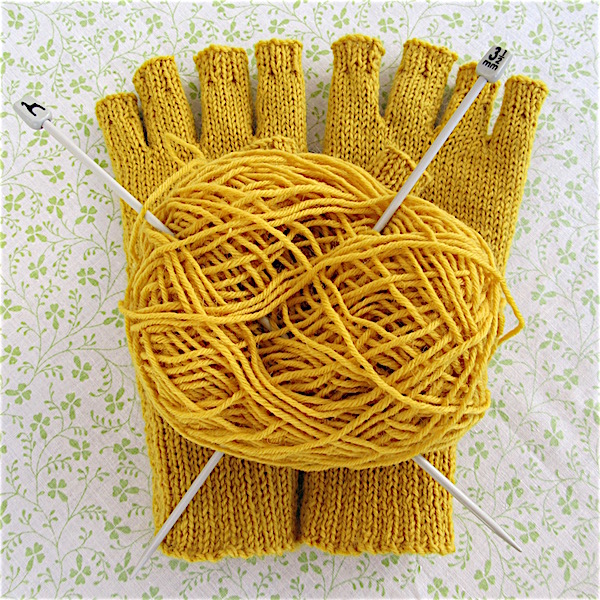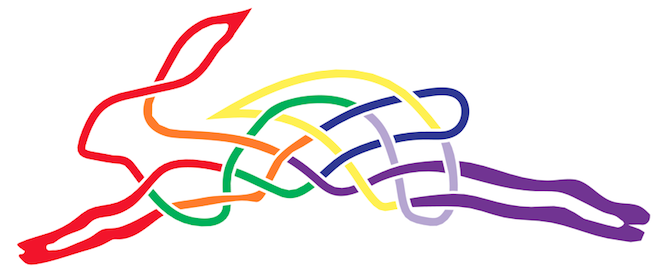
Welcome again to Wool on Sundays :)
This week I have made a pair of fingerless gloves and I thought, as change from just showing you a couple of photos, I’d explain the rationale behind my making. So here are three reasons why these gloves are a good fit with the way I try to live (without, I admit, as much success as I’d like):

# 1
No human has been exploited in the production of these gloves. We all all know that having cheap, disposable, fast fashion garments for sale on our high streets is only possible because other people are suffering and sometimes even dying in the merciless chain of production that fuels the fashion industry. If you haven’t seen it, I very much recommend taking a look at The Sweat Shop, which is a brilliant documentary/reality TV series following some fashion conscious Norweigen teenagers who are taken to visit Cambodia to meet and work with the people who make the clothes that we see see for sale in well known stores on high streets throughout the world. It is descriptive rather than didactic and offers information rather than solutions. I very rarely buy new clothes to avoid funding this industry and, instead, I either make or buy clothes from charity shops or occasionally I buy clothes or shoes from countries in the EU, where I am aware of the labour laws in place, though it often unclear where the materials to make these things come from. There are, however, many areas, such as fabric, fuel and electricity where I have failed to find any reliable ethical way of avoiding contributing to human suffering.

#2
No animal has been harmed in the production of these gloves. I completely avoid yarn made in China on account of their human rights violations and appalling record on animal welfare. Otherwise, I investigate companies as best I can but I’m actually quite lazy and tend to stick with brands I feel I can trust. I mostly use Drops yarn, made in the EU, and I take some heart from the fact that ‘All the Merino wool in the DROPS yarns has its origins in South America, coming from sheep that have not been subject to Mulesing’ (Garn Srudio FAQ), though I would prefer clarification on the general standards of animal and workers’ welfare. Having kept a small flock of sheep and had to deal with fly strike first hand, I am well aware of the implications of fly strike and the problems surrounding dealing with it but I think the arguments for keeping and mulesing merino sheep is a modern equivalent to the arguments in favour keeping the slave trade as an economic necessity and I consider it to be a barbaric and unacceptable practice. For these gloves I used Aire Valley DK, which is produced by the West Yorkshire Spinners. I contacted them to double check about the sheep they use and I was assured by a lady called Emma that all of their wool is ‘reared, sheared and spun in Britain (apart from the Norwegian)’ and they ‘work very closely with our wool merchants to make sure that the wool that we buy is of the highest quality and meets our own exacting standards’. I was very happy with how the wool knitted up and I shall certainly be buying from them again in the future.

# 3
They fit – like a glove, as they say. Most gloves, and clothes in general, are understandably produced to generic sizes or even ‘one size fits all’ so it’s a rare thing to find anything really fits. So often a waist is a bit high or a bit low or an otherwise perfect garment could do with a pocket…With these gloves I wanted to have the fingers as long as possible, for warmth, without having to overly fumble about or take them off when working outdoors and because I made them myself I could measure as I went and make the cuffs just as I wanted and each finger exactly the right length. I also love the colour!

An important consideration I have not touched upon in this post is the environmental question. From a point of energy conservation it must be better to buy things produced as locally as possible and natural fibres are obviously more biodegradable than man made ones at the point of disposal but I don’t know how the production and processing impacts compare or how this would all level out over the ‘lifetime’ of an object.
Thank you if you have read this somewhat soap boxy edition of Wool on Sundays! Feel free to agree or disagree with any/all of the above. I would be very interested to hear of other ethical suppliers of wool or anything else or about how you navigate through the complex world we live in. Next week, I expect, I will be back to my usual quiet, makerly Sunday posts :)
In the meantime, if you have any wool/yarn posts to share, I’d love you to link up. The rules, as usual, are: 1). Posts must include some content – makes or musings or photos – related to knitting, crochet, felting, spinning or yarn. 2). Projects sewn from felt or wool fabric or stitchery using wool are also welcome but please don’t link posts that are exclusively about sewing, quilting and fabrics. 3). Posts don’t have to be from the past week but please put a link to WOOL ON SUNDAYS or grab the button from my sidebar and include it in or at the bottom of any posts you link up. 4). MOST IMPORTANT visit anyone else who links.
Janine @ Rainbow Hare
Please click on the button below to link up or view the posts that have. :)



MrsCraft
Great post, it’s easy to buy things without considering where it’s from or how it was made. Beautiful gloves too. 😊
LikeLiked by 1 person
Kim Sharman
A thought provoking post, Janine…thank you. It is strange but my husband and I were only talking about India, Bangladesh and China yesterday and the production of garments industry. My husband was born in Calcutta, India and lived there for 18 years before he emigrated to Australia, so he has seen first hand life and conditions in India. In saying this, he has interesting insight in both sides of this discussion. I must look at the documentary you linked up, it does sound very interesting. Your gloves are cool. You knitted them up quickly. I imagine you will need them to keep your hands warm in the not too distant future.
LikeLike
Janine @ Rainbow Hare
Thank you, I would be very interested to know your husband’s views, Kim. I think there is a very good counter argument that we can only help emerging economies by trading with them and really I am just sidestepping the problem, rather than helping anyone. I actually find it an intractable conundrum. A while ago, I saw a post from someone in India about child labour in India and I asked them what they thought western consumers could do and they said nothing – the parents had to stop it and the government should enforce laws against it. Of corse there is the Fair Trade movement and there are some companies and organisations that have and promote ethical standards but I wish there was more information on a company by company basis.
LikeLiked by 1 person
SomedaySewing
The gloves are beautiful! Often times people think my hand made clothing is about making clothes cheaper than you can buy them and it isn’t about that. It’s a nice side-benefit if you can manage it! For me it’s about fit and not buying a 5 dollar t-shirt disposable that doesn’t really fit or have a long life.
LikeLiked by 1 person
Carol
I’ll be looking at the video. Terry and I were just talking about this issue the other day. I don’t think there is anything we can do to help the situation. Also, it’s hard to avoid buying things that are made in…say China…. In the US their goods are everywhere. But I really do try to be selective in my purchases. For me, fair trade, production conditions, animal rights are important. To buy made in the USA is important. I admit at my age, I am not buying much in durable goods unless it is a necessity and trying to use what we have. If purchasing person educated themselves to where items come from and the labor force employed to make it, we might make a difference. The percent of the population that cares is too small.
this was a good post.
xx, Carol
LikeLike
jesh stg
I’ll do sweaters, but haven’t conquered the smaller things like socks (one time, uh conflicted:) ) or mittens. even less fingers!
LikeLike
Maria
A gorgeous pair of gloves Janine! A very thought provoking post on looking at how our yarn is produced. It was interesting to read about companies that produce yarn in an ethical and sustainable way. It’s criminal that big companies like Patons ( Patons yarns have been popular in Australia for years but isn’t really Australian owned) are producing their yarns in China now. Most of the Aussie mills/spinners have closed…very few left. I’ve been away and even though I wrote a WoS post I didn’t link earlier.
LikeLike
soma @ whimsandfancies.com
That is amazing and quite commendable, Janine. Great post!! I myself try to purchase products made in the US and Europe as much as possible, even if they cost me extra. It has not been easy to find such products though. Needless to say, just like you, I wouldn’t even consider yarn from China.
The gloves are gorgeous made with that bright, beautiful, yellow yarn! It must make you smile every time you wear them :)
-Soma
LikeLike
Pingback: Wool on Sundays – 139 (West Yorkshire Spinners Yarn) – Rainbow Hare